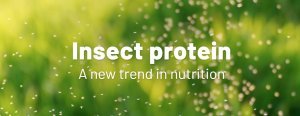
 Krmivo-Eminent.cz
Krmivo-Eminent.cz

Pet food with INSECT. Find out more in the article below.
Insects - the protein of the future
In recent years, population growth, rising living standards, consumerism and urbanization have been increasingly discussed. With an ever-increasing population, our planet is sorely tried and environmental issues and the impending food crisis are also coming to the fore.
Alternative sources of protein are increasingly discussed in scientific and food circles. Of course, pet food manufacturers could not avoid this topic either. In our sector where the pressure on animal protein in pet food is really high - often its content is taken as a sign of product quality - such solutions are sought that could provide an acceptable concept for owners, meet the nutritional requirements of pets and at the same time be tasty for our four-legged friends. Insects could represent the way out of this difficult situation. Insect-based food and pet food are slowly shifting from the theoretical level into the form of real products and, based on the knowledge gained, are being promoted as one of the possible solutions to the environmental crisis.
Let's take a closer look at this issue and add a few interesting facts to consider when deciding what pet food you will reach for the next time you wander among the shelves in a pet shop.
Farm animals produce a quarter of the total protein consumed on Earth in the form of food. However, livestock farming has a significant environmental impact on the planet. The area of pastures and land on which the crops are grown, that are later used for fattening livestock, is twice the area on which the crops for direct consumption are grown. Cattle breeding is also associated with the production of greenhouse gases, especially methane. In total, livestock farming is responsible for 12% of greenhouse gas emissions. Water consumption to produce 1 kg of beef is approximately 15,000 litres. The combination of these factors has a negative impact on the climate and contributes to global warming.
In terms of breeding, insects have lower demands on water, soil and space compared to conventional livestock production. Water consumption per kilogram of protein produced is 95% lower for insects than for beef.
However, the biggest advantage of insects as feed material is the high conversion of this feed to biomass, when compared with other animal proteins. This means that less feed is needed to obtain 1 kilogram of insect protein than to obtain one kilogram of beef or chicken. Another indisputable advantage lies in the possibility to feed insects with organic materials that are considered waste in the food industry (there are strict legislative restrictions in this regard). This could reduce pollution, promote the circulation of usable materials and also reduce the production costs.
There are many species of edible insects. Among them, there are a few candidates who appear to be suitable for the use in dog and cat food. These are: houseflies, crickets, mealworm larvae, soldier fly larvae and possibly also cockroaches. All these species are able to quickly and easily convert food into biomass, are easy to breed and have low space requirements.
The key question remains whether the insects represent a suitable choice for the bowls of our pets. Although this is a relatively new line of thought and the data is limited so far, it looks very promising based on the available results. Insect meal contains a high level of protein (between 33-63%) and the amino acid profile is similar to that of fish and poultry meal. Insect meals are also high in vitamins and minerals.
And how does a larva become a kibble? It all starts with the processing of insects into insect meal, which is then used as a raw material in the production of kibbles.
Because we are interested in a raw material with a long shelf life and a high protein content, it is necessary to treat insects. If we processed "fresh" larvae, we would get a paste-like mass with a high water content that would need to be processed quickly. Due to the high water content, this mass is prone to spoilage and the quality of the raw material is deteriorating rapidly. Therefore, the first production step is drying, which reduces the water content in the raw material to 5-10%. Unwanted microorganisms can no longer reproduce in the material treated in this way. At the same time, the deterioration of the raw material quality due to chemical changes is avoided. The resulting product - insect meal - is safe and durable.
Another issue to consider is lipid oxidation. Insect larvae have a high fat content, which is highly prone to oxidation. Therefore, insect meals with different fat contents are produced. The less fat the meal contains, the more stable it is and its taste profile remains unchanged for a longer period of time.
Insect meal treated in this way is a suitable raw material for the production of kibbles that end up in your dog's bowl.
And what does it all mean for you?
Of course, we believe that meat belongs to the bowls of our dogs. Classic kibbles containing chicken, beef or fish are perfectly fine and feeding them is not a sin. But we cannot ignore the fact that meat production is a huge burden for our planet. So, the next time you want to try something new, reach for an alternative source of protein and bet on insects. Sooner or later, we will all have to look for solutions and compromises, because we only have one planet.